ON APRIL 20—HITLER'S BIRTHDAY—GENERAL PATTON'S PLANE WAS STRAFED BY AN RAF SPITFIRE. THE SPITFIRE
CRASHED AND PATTON TOOK PICTURES OF THE PLANE AND THE PILOT. THAT EVIDENCE WAS ENOUGH TO GROUND THE "SPECIAL RELATIONSHIP" BETWEEN THE U.S. AND THE BRITISH EMPIRE FOREVER!! |
General George S. Patton Jr. is considered one of the greatest United States generals. A New World Alexander the Great and Julius Caesar combined, only General Sherman ranks him....Unfortunately, George's grandfather fought for the rebels, while General Sherman fought to save the Union. Warfare is 75% spying and deception, but that aspect of warfare did not appeal to a straight shooter like General Patton.
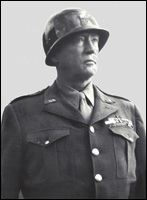 General George S. Patton Jr. (1885–Dec. 21, 1945. |
|

Generals Brooke, Bradley, and Montgomery,
greet Patton upon his arrival in France, July 7, 1944. |
Patton knew that his New World citizen soldiers were the best in the world, and given logistical support he would be in Berlin in a matter of weeks. He was the master of blitzkrieg or lighting war, and no soldier in the Third Army would ever think about surrendering to the enemy.
On the other hand, "Monty" had nothing but disdain for Patton and his Third Army, which he derisively called "Our Italians."
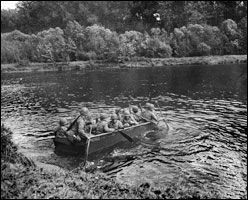 Third Army soldiers crossing the Moselle River, Sept. 8, 1944. |
|
 "Field Marshal" Bernard Montgomery (1887–1976) was Dunkirked in 1940. |
That was the same General Montgomery who was Dunkirked in 1940, and evacuated quickly when the Nazis invaded France!
Operation Market Garden was designed to bring General Patton's Third Army to a complete halt. Additionally it was designed to sow confusion among the U.S. generals and reverse the battlefield losses of the Nazis:
Once again he (Montgomery) was demanding what he always wanted: Absolute priority, which to his mind would guarantee success. Eisenhower noted in his diary for September 12: "Monty's suggestion is simple—'give him everything.'" Fearing that any delay might jeopardize Market Garden, Eisenhower complied. He promptly sent his chief of staff, General Bedel Smith, to see Montgomery. Smith assured the Field Marshal of a thousand tons of supplies per day including transport. Additionally, Montgomery was promised that Patton's drive to the Sarr would be checked. Elated at the "electric" response—as the field marshal called it—Montgomery believed that he had finally won the Supreme Commander over to his view. (Ryan, A Bridge Too Far, p. 113).
It is amazing that General Eisenhower acquiesced to such a farcical operation. At that stage "Monty" outranked him, and he might have been afraid that Kay Summersby would slip him a Mickey Finn, or he would have been strafed by RAF Spitfires.
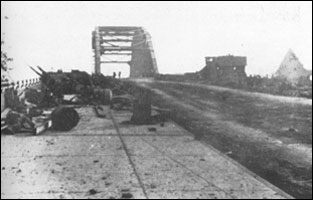 Arnheim Bridge was still controlled by the Nazis Arnheim Bridge was still controlled by the Nazis at the end of Operation Market Garden! |
|
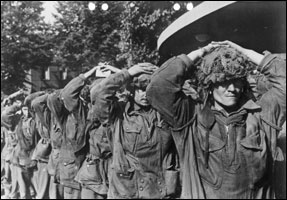 British paratroopers eagerly surrendered to the Nazis. |
Remarkably, even Adolf Hitler stopped using airborne troops after the disastrous invasion of Crete in 1941. No Nazi airborne troops were used in the Battle of the Bulge.
Combined British, U.S. and Polish casualties totaled almost 17,000 men out of a combined force of over 40,000 airborne troops. Additionally, almost 100 tanks were lost versus German losses of only 30 tanks. It was the worst defeat for the "Allies" during the entire war. Winston Churchill and his protégé Monty were not so bulldogish during that disastrous operation.
Monty's failed Market Garden gave the Nazis time to prepare for a major counteroffensive!
From a U.S. perspective, Operation Market Garden was an unmitigated disaster, but Monty saw it as a rousing success because it halted the advance of General Patton. Additionally, it gave the Nazis time to launch Hitler's last great gamble called Operation Watch on the Rhine.
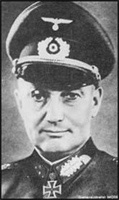 Field Marshall Walter Model (1891–1945). |
|
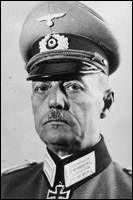 Field Marshal Gerd von Rundstedt (1875–1953). |
Additionally, 2 fanatical Waffen-SS men were selected to lead the operation: Colonel Joachim Peiper and Hitler's own bodyguard Sepp Dietrich.

SS Colonel Joachim Peiper
(1915–1976). |
|
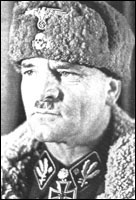 SS-Waffen commander Sepp Dietrich. |
Hitler's favorite spy and all around trouble shooter named Otto Skorzeny was selected to head Operation Grief or Griffin. A griffin is a demonic human animal hybrid which is featured prominently on the Bayeau Tapestry.
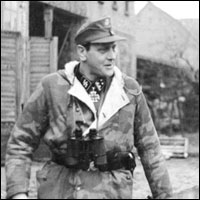 Austrian Otto Skorzeny (1908–1975). |
|
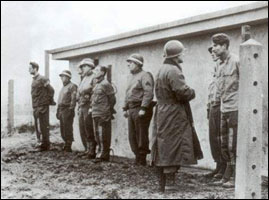 Captured Nazis from Operation Grief were immediately shot as spies. |
Those saboteurs did cause chaos behind the lines, but when they were captured they were shot as spies. Amazing, Skorzeny survived the war, and he later worked for the Kosher Nostra Mossad as an executioner.
General Patton saved the U.S. from defeat at the Battle of the Bulge!
Operation Watch on the Rhine was soon called the Battle of the Bulge by U.S. reporters. It took the U.S. forces completely by surprise, but it was no secret to the British, who were reading the Nazi Enigma ciphers.
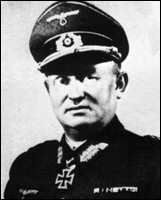 General Heinrich von Lüttwitz (1896–1969). |
|
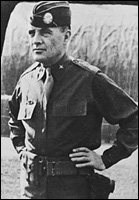 General McAuliffe (1898–1975). |
A very brave reply indeed but Bastogne would have been another Alamo except for the timely arrival of General Patton. At the start of the Nazis offensive, General Patton was still spinning his wheels on the southern border of Germany—going nowhere....Immediately, he turned his army around and raced north to relieve Bastogne.
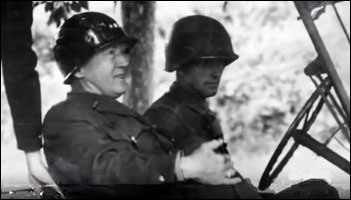 General Patton and his driver, Francis "Jeep" Sanza, on their way to Bastogne. |
|
 Patton awarding medals to General McAuliffe and Colonel Steve Chappuis, Dec. 30, 1944. |
After the relief of Bastogne, Patton's Third Army was finally able to cross the Rhine into the dark heart of Nazi Germany. His next destination should have been Berlin, but he was denied that prize, and the Russians took the city instead.
General Patton was strafed by a Spitfire on Hitler's birthday!
Incredibly, General Patton was almost killed on April 20 when he was strafed by a Spitfire. The general was visiting division headquarters when his small Piper "Cub" was suddenly ambushed by a fighter plane.
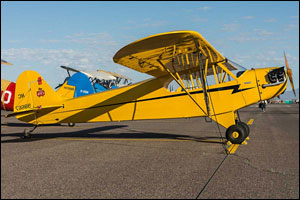 General Patton used a small Piper "Cub" to travel to the various division HQ's. |
|
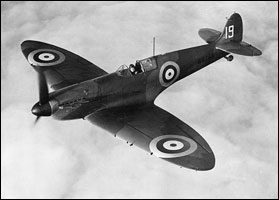 General Patton was ambushed by a deadly RAF Spitfire. |
General Patton mentioned that deadly assassination attempt in his expurgated Memoirs, which were published posthumously:
From here we flew to the Headquarters of the III Corps at Reidfield. Just before we got there, I noticed some tracers coming by the right side of our plane which, at the same instant, dove for the ground, very nearly colliding with a plane which looked like a Spitfire. This plane made a second pass, again firing and missing. By this time I was sure we were being attacked and decided that, since there was nothing else to do, I would try to get a picture of the assailant, but was so nervous I forgot to take the cover off the lens; so the picture was a blank. On the third pass, our attacker came in so fast and we were so close to the ground that he was unable to pull out of his dive and crashed, to our great satisfaction. While Codman and I were engaged in hedge-hopping to avoid this belligerent gentleman, four other planes were circling over us, but did not engage in the attack. (Patton, War As I Knew It, p. 307).
Image the fearless combat commander too "nervous" to take the lens cap off the camera. Patton did get a shot of the plane, and he visited the wreck of the crashed plane and took more photos. That was why the general had to be assassinated because he had irrefutable evidence that Churchill and Montgomery were trying to kill him and blame it on the Russians.
Bestselling author Bill O'Reilly said that General Patton was so TERRIFIED that he forgot to take the lens cap off the camera.
Patton reached for his camera. He snaps several pictures of the RAF plane, even as his pilot takes desperate evasive measures that make the Spitfire miss them a second time. Patton is so terrified that he forgets to take the lens cap off the camera. His aircraft is no match for the Spitfire, which was so famously effective at defeating German Messerschmitt fighter planes during the Battle of Britain. (O'Reilly, Killing Patton, p. 241).
That was the same general who was almost relieved of his command for slapping a solider for cowardice!
The general also had pictures of Hitler's top secret weapons that would have caused a lot of heads to roll if they were published in the United States.
General Patton was assassinated by General Gay and his driver!
Everybody who colluded with Churchill, Montgomery, and Hitler feared exposure when the fearless general returned to the United States. General Patton was even mentioned as a Presidential candidate.
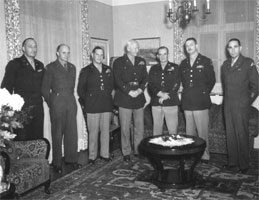 Patton's last command was the Patton's last command was the phantom Fifteenth Army. |
|
 Patton poses with the limousine in which he took his last ride. |
Patton took the hint that he was no longer welcome in Germany and decided to resign and return home. He never even returned home in a coffin because he was assassinated by General Gay and the limousine driver.
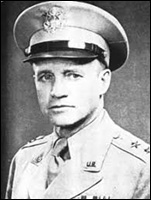 General Hobart Gay (1894–1983). |
|
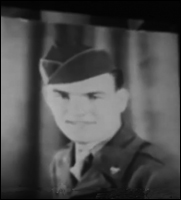 Driver Horace Woodring (1926–2003). |
It was the perfect ambush from inside the limousine—a precursor to the Kennedy assassination!
The general was immediately paralyzed from the waist down. As soon as the train passed, 2 trucks were waiting up ahead to block the road and stage a "car accident."
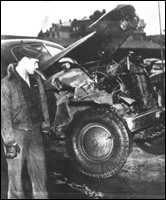 Woodring standing next to the limousine. |
|
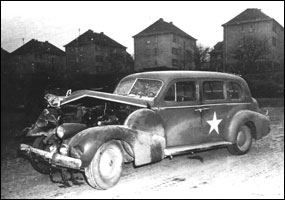 Patton's so-called limousine Patton's so-called limousine after the "fatal crash." |
Coincidently, an ambulance happened to be in the vicinity when the "crash" occurred, so Patton was rushed to the hospital. Once Patton was out of sight, one of the trucks was driven into the limousine to stage a "car crash."
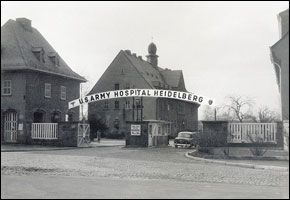 The U.S. Army Hospital in Heidelberg where Patton was taken by ambulance. |
|
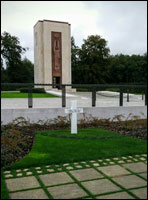 The grave of General Patton in the American Cemetery in Luxembourg. |
Most thinking people believed that Patton's death was no "accident." Naturally, Winston Churchill saw the mysterious death of the general as a unique opportunity to ignite the Cold War.
Naturally, the Russians were blamed for the death of General Patton!
Patton had no interest in fighting the Soviets or driving them from Berlin. When the war in Europe was over, he requested a transfer to the Pacific, but his request was denied by General Douglas MacArthur.
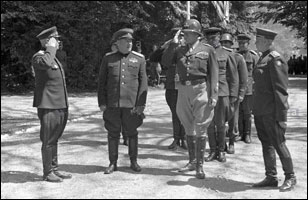
Patton saluting Soviet Marshal Tolbukhin, Vienna, June 1, 1945. |
|
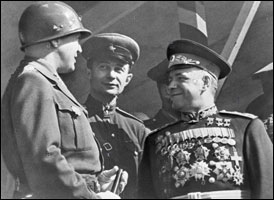
Patton and Marshal Zhukov at the 1945
Victory Day Parade in Moscow. |
The assassination of General Patton bears an eerie resemblance to the later assassination of President Kennedy. Both assassinations took place in an automobile, and both shots came from inside the car. Likewise, the cover-up in both assassinations was extraordinary!
Vital links
References
Beevor, Antony. Ardennes 1944: The Battle of the Bulge. Penguin Random House, New York, 2015.
Caddick-Adams, Peter. Snow & Steel: The Battle of the Bulge, 1944–45. Oxford University Press, New York, 2015.
Eisenhower, Dwight D. Crusade in Europe. Doubleday & Company Garden City, New York, 1948.
Messenger, Charles. Hitler's Gladiator: The Life and Wars of Panzer Army Commander Sepp Dietrich. Skyhorse Publishing, New York, 2011.
O'Reilly, Bill. Killing Patton: The Strange Death of World War II's Most Audacious General. Henry Holt & Company, New York, 2014.
Patton, General George S. War As I Knew It. Houghton Mifflin Company, Boston, MASS, 1947.
Parker, Danny S. Hitler's Warrior: The Life and Wars of SS Colonel Joachim Peiper. Da Capo Press, Boston, MASS, 2014.
Ryan, Cornelius. A Bridge Too Far: The Classic History of the Greatest Airborne Battle of World War II. Simon & Schuster, New York, 1974.
Wilcox. Robert K. Target Patton: The Plot to Assassinate General Patton. Regnery Publishing, Washington City, 2008.